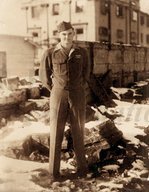
|

|
|
|
|
Curtis was born in Texarkana, Texas, as one of five children. His father was "more or less a sharecropper. He farmed. We moved around quite a bit from one place to another," Curtis recalls. His mother was Viola Evans Earnest. (He doesn't give his father's name). Curtis picked cotton, a task that toughens one's fingers. "They're just like picking a guitar," he says of cotton. "Your fingers get tough when you're picking those burs." His boyhood seems typical of farm life in the rural South in the Depression. The children helped with farm chores. The family grew much of their own food. His mother cooked on a woodstove. The house had neither electricity nor indoor plumbing "until we got just about grown." They listened to a battery-powered radio. They stored food in an icebox with bought ice, and kept dairy products in the well. They traveled by mule and wagon. Curtis graduated from Hooks High School in Hooks, Texas in 1943. Drafted, he entered the U.S. Army, entering on October 4, 1944. After basic training at Mineral Wells, Texas, he was sent to Fort Ord, California. Curtis sailed to the Pacific on the USS Henlopen on a thirty-six-day voyage. At Leyte in the Philippines he was placed in Company C, 132nd Infantry Regiment of the Americal Division as a rifleman and BAR man. Sent to Cebu Island, he went on numerous platoon-size patrols. He was involved in several firefights . "I tasted a lot of those bullets coming behind my head," he says of the action. When the war ended he was still on Cebu, training for the invasion of Japan. The remaining Japanese on the island were reluctant to surrender. "They couldn't convince the Japs up there that the mainland had surrendered. They got a prisoner somewhere and let him come down and listen to some radio broadcast. Then they surrendered. I think it was about three thousand still up there in those hills," he says. Curtis went ashore at Yokohama for the occupation of Japan. He was stationed at Fujisawa, then Sendai, then Tokyo. He was transferred from the 132nd into an engineering company, in which he drove a dump truck and other vehicles in road repair work. Curtis was discharged at Fort Sam Houston in San Antonio. Back home in Texarkana, he went to work at the post office. He met Eugenia Burns, and they were married on October 8, 1950. The couple had two children. They moved to Shreveport in 1975 where he continued working for the postal service. |


